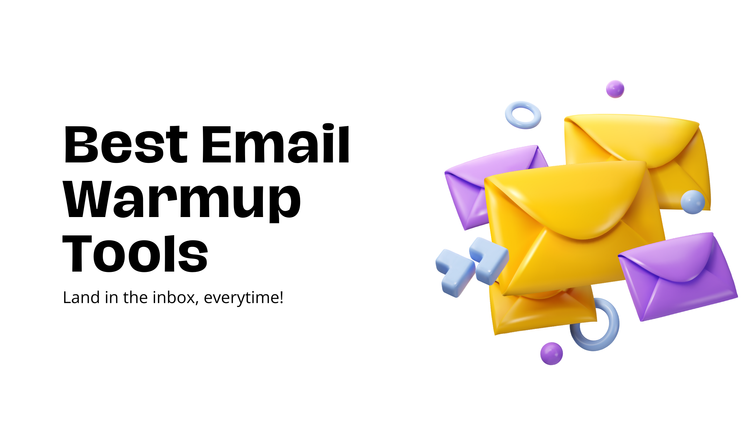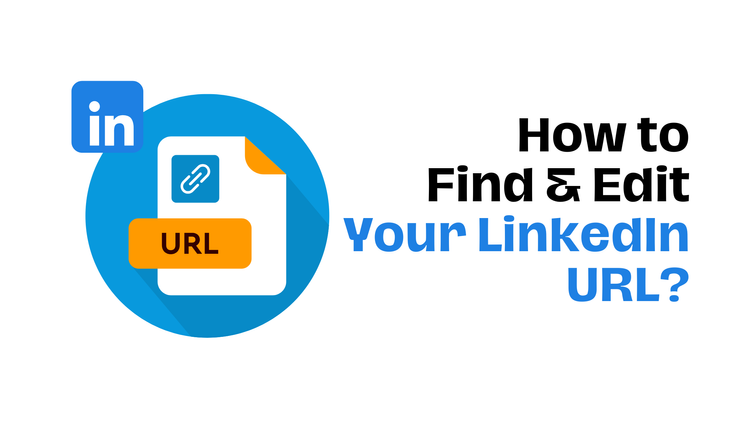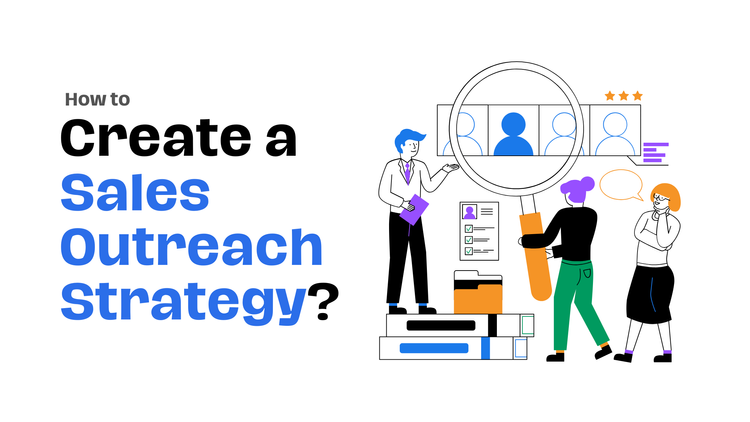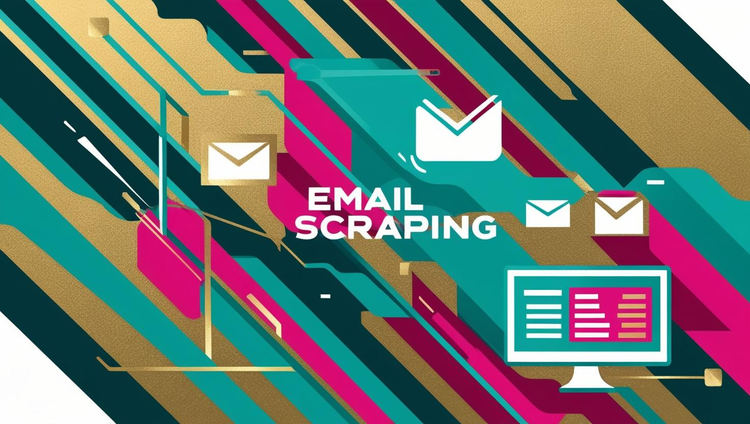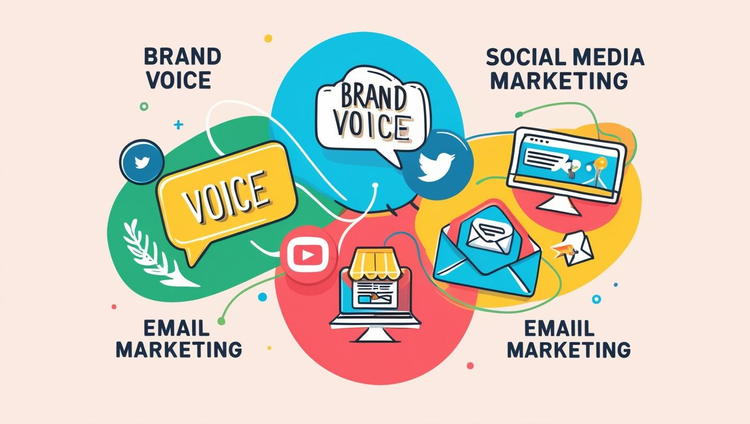AI Email Marketing: Strategies & Tools for 2025
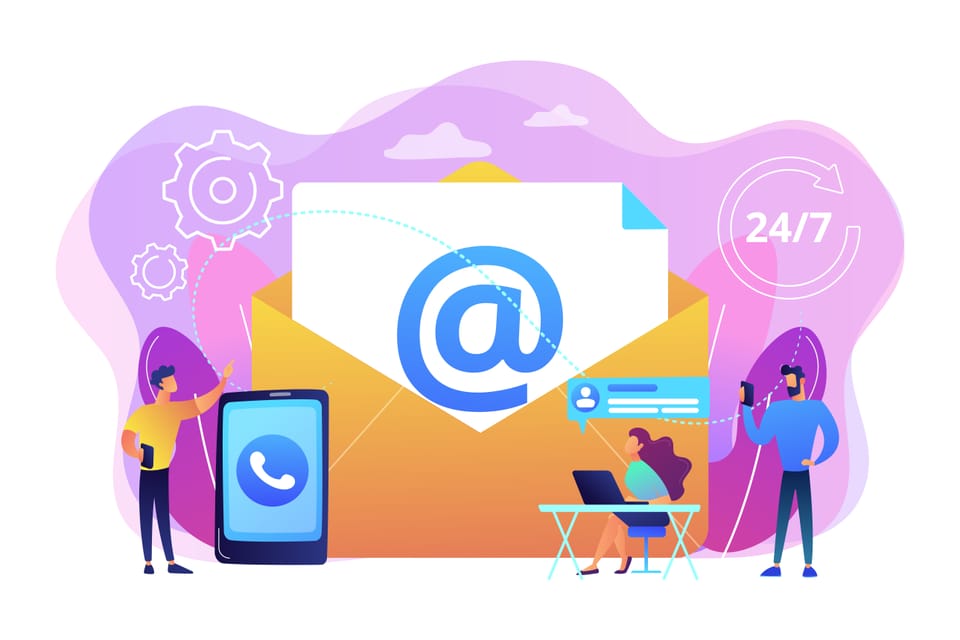
Can AI email marketing really improve your results? Will it save time? Is it just another overhyped trend?
The short answer—yes, AI email marketing can significantly improve engagement, automate tedious tasks, and increase ROI. It's not an overrated strategy, it does actually work.
In this guide, we’ll break down everything you need to know:
✔️ How AI personalizes email campaigns at scale
✔️ The best AI tools for writing, optimizing, and automating emails
✔️ Real-world use cases and best practices
✔️ The pros and cons of AI email marketing
What is AI Email Marketing?
AI email marketing uses artificial intelligence to automate, personalize, and optimize email campaigns. Instead of relying on manual effort, AI-powered tools analyze data, predict customer behavior, and generate tailored content to increase engagement and conversions.
With AI, businesses can:
- Automate email sequences based on user actions.
- Personalize subject lines and content for higher open rates.
- Optimize send times for maximum engagement.
- Analyze campaign performance and suggest improvements.
Best 8 AI Email Marketing Tools
Let’s overview the most noteworthy AI solutions that will simplify your email marketing tasks.
How do you choose the most suitable one? The answer is, “It depends on your needs.” As you can see, these tools serve various purposes, from lead generation to optimizing email send times. So, you may even need to leverage several solutions simultaneously.
Start with determining the aspect of your email marketing strategy that needs enhancement the most. Do you need assistance with content creation, grammar check, or delivery optimization? Then, make sure it’s compatible with your existing email marketing platform to integrate it smoothly.
How to Master AI Email Marketing: Step By Step
That’s where things get practical. Let’s break down the email creation process using the example of ChatGPT and how you can benefit from it in your daily tasks. We’ll provide tips, prompts, and examples to illustrate the main ideas. Here are a few pointers:
- Come up with clear, specific requests. Need a product launch email? Say so. Include critical details like your target audience, product features, and the tone you’re aiming for. The output quality depends on the precision of the prompt.
- Specify your brand voice. The tool adapts to the desired tone of voice, whether you want to sound professional or casual.
- Iterate and evolve. Don’t settle on the first draft. Tweak and refine it to write from different angles and see what sticks.
Now, it’s time to examine how ChatGPT works at each stage of email creation. For additional resources and courses on using ChatGPT, have a look at DataCamp's resources to deepen your understanding and skills.
Stage 1: Creating the Subject Line
What you may ask: “Generate a catchy subject line for a [Product/Service Name] launch email targeting [Target Audience].”
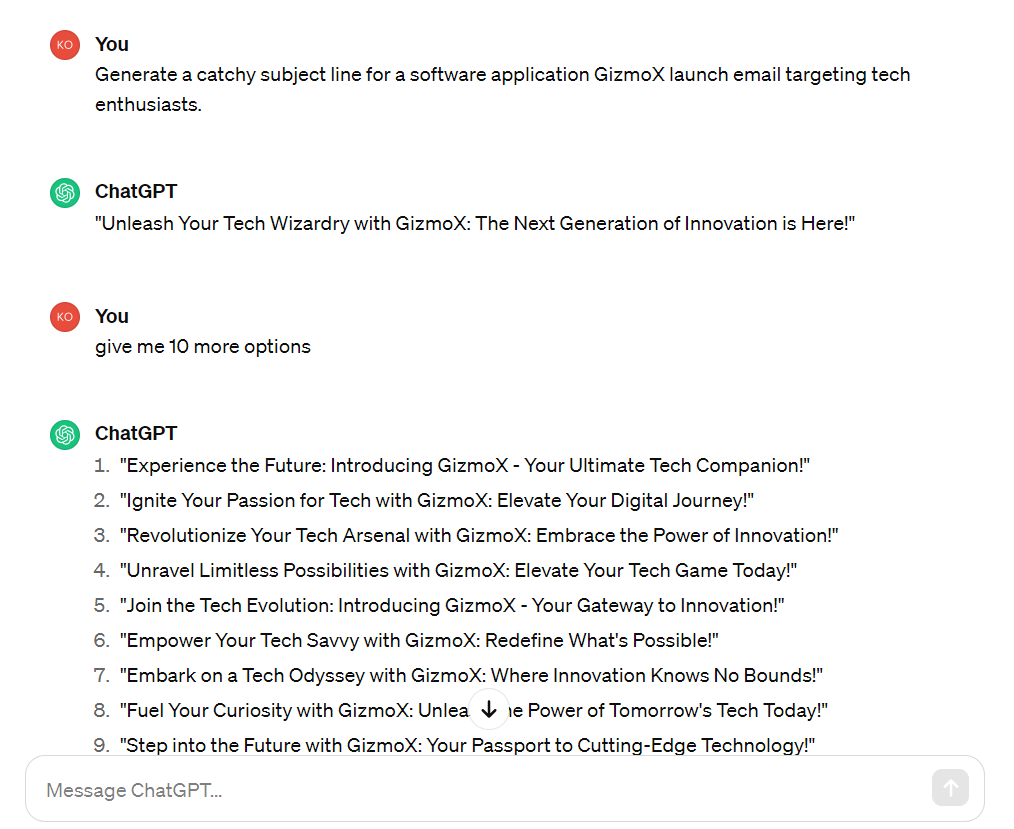
Tip: Input details about your product or service, emphasizing unique selling points and your target audience.
Stage 2: Crafting the Email Copy
What you may ask: “Write a concise email body for our [Product/Service Name] launch, addressing [Target Audience]. Focus on [Key Features/Benefits]. Keep the tone [Desired Tone, e.g., professional, friendly].”
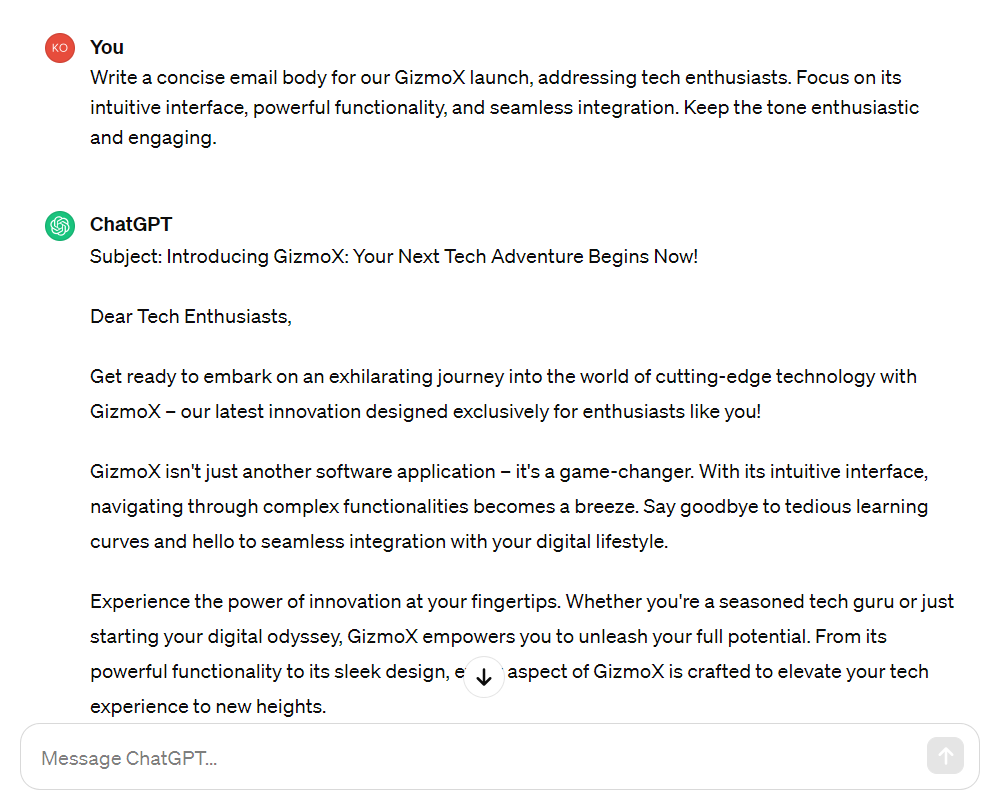
Tip: Specify what you want to stress in the body of your email: key benefits, features, and any particular tone or style.
Stage 3: Personalizing the Content
What you may ask: “Personalize the following email draft for [Segment of Your Audience], emphasizing [Specific Interest or Need].”
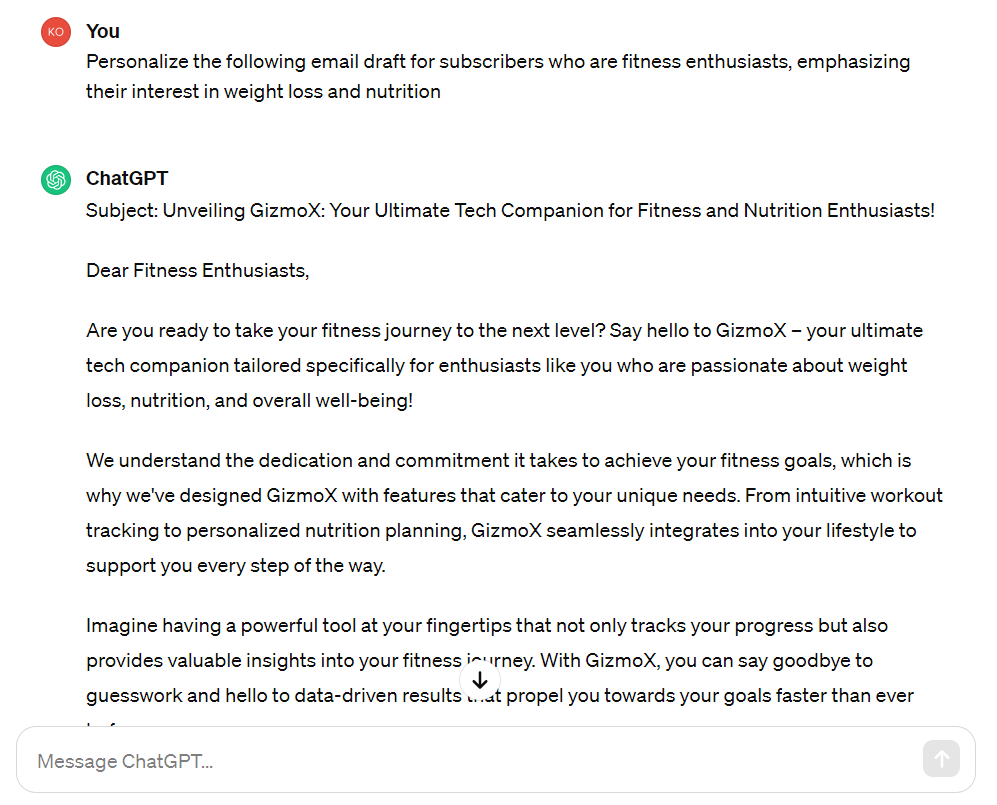
Tip: Focus on different features or benefits that appeal to specific customer groups.
Stage 4: Coming up with Calls-to-Action (CTAs)
What you may ask: “Create a compelling CTA for our email that encourages [Desired Action, e.g., signing up, making a purchase] related to [Product/Service Name].”
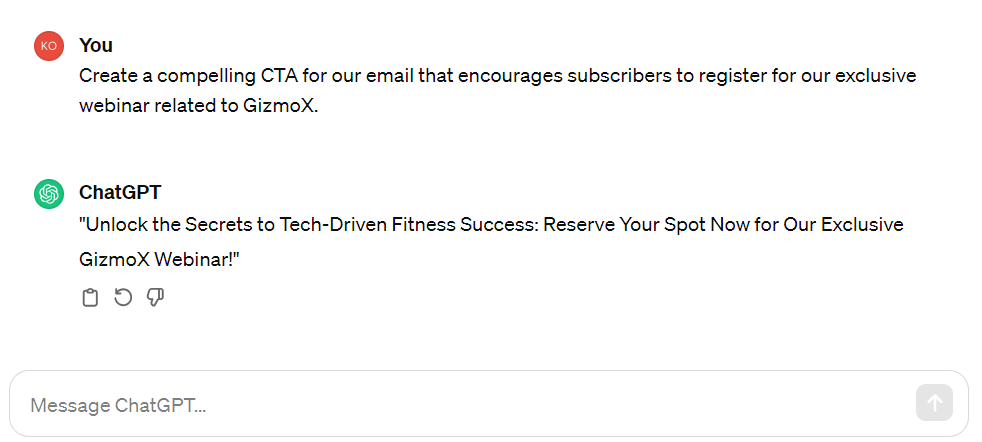
Stage 5: Conducting A/B Testing
What you may ask: “Provide two variations of the email subject line/body/CTA for A/B testing, focusing on [Key Aspect for Testing].”
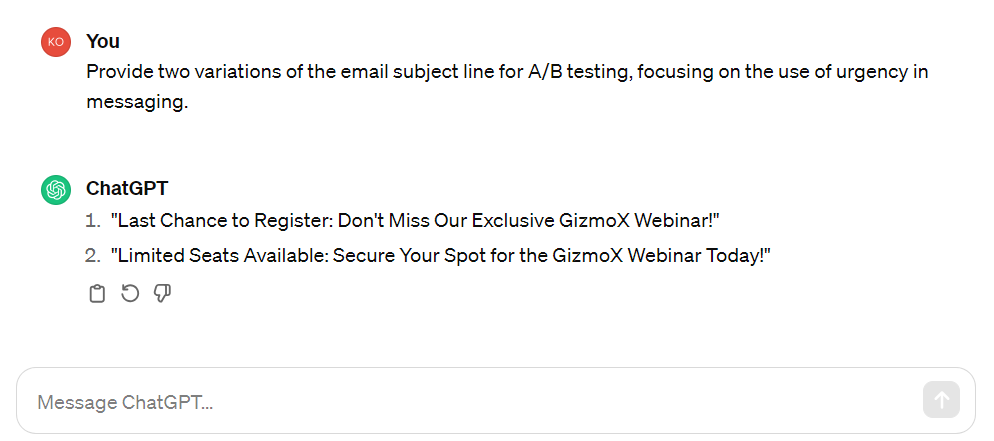
Stage 6: Ensuring Compliance and Checking for Bias
What you may ask: “Review this email for any potential bias or non-compliance with [Specific Regulation, e.g., GDPR]. Suggest edits if needed.”
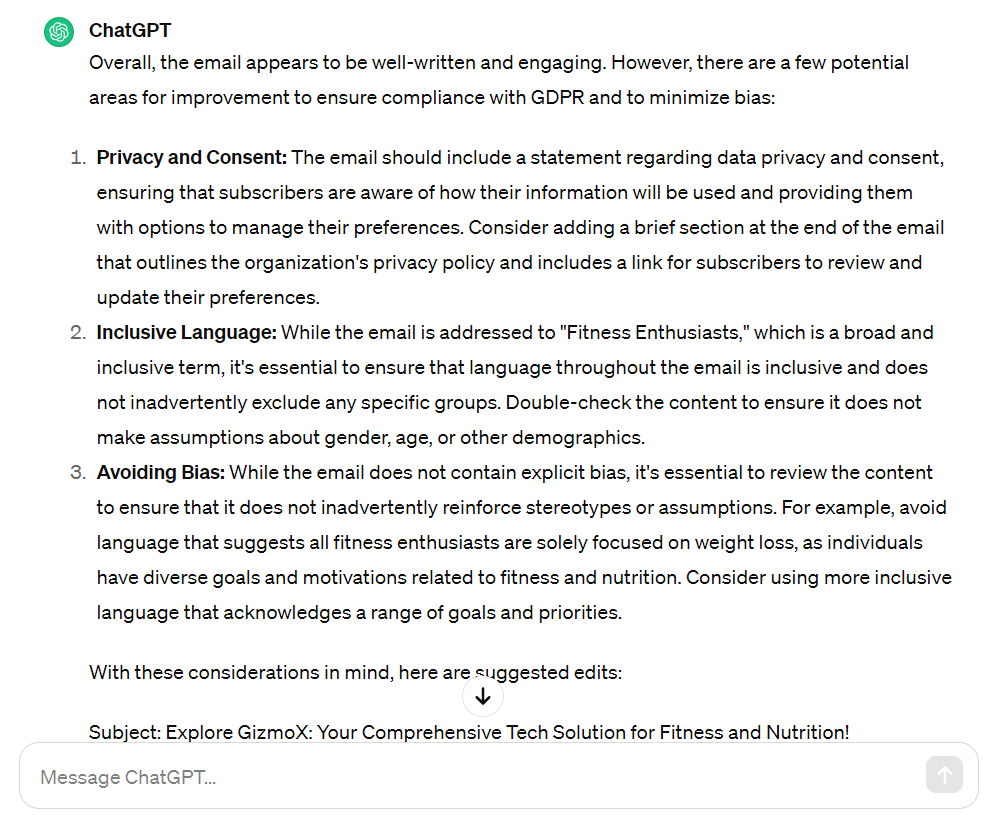
Tip: Always have a human eye review AI-generated content. ChatGPT can make mistakes, but it can also help fix them and check the email for compliance with legal standards and biases.
AI Email Marketing: Key Benefits
Before we delve into practical tips for implementing AI in email marketing, let’s first examine some of its advantages, such as:
- Personalization at scale: You can start all your messages sent in bulk with the recipient’s personal name and craft copies that resonate with their specific needs and interests.
- Timing and frequency optimization: Users may more actively open emails delivered at the right time. AI lets you determine the perfect time slot for better engagement.
- Advanced segmentation and targeting: AI analyzes factors like past purchases, website interactions, and social media behavior to inform your email marketing strategy. As a result, you’re targeting people with content that’s relevant to them.
- Accelerated insights and analytics: AI operates in a flash, so you can get real-time insights about what’s successful and what’s not. You can fix underperforming parts before the campaign ends or harms your business performance.
- Efficiency and cost-effectiveness: With AI, you and your team no longer have to get stuck with the grunt work, like scheduling emails and managing lists. It frees up time for strategic and creative tasks, boosting productivity, reducing labor hours, and bringing financial savings.
AI Email Marketing: Key Challenges
- Integration hurdles: You’ve most likely been utilizing many other tools before opting for AI. That’s where compatibility issues may arise. Choose AI solutions that offer easy integration with popular email marketing platforms. Look for APIs and plugins that sync with your current setup.
- Ensuring deliverability: It’s a common headache among marketers trying to bypass spam filters and get through to the recipient’s inboxes. Employ AI apps to optimize email content for deliverability to avoid punishment from internet service providers (ISPs).
- Subscriber growth and retention: Encouraging more people to subscribe to your newsletter is a painstaking process. AI simplifies it with lead scoring, predictive analytics, and other features, attracting high-quality leads who are potentially most interested in your content. Just beware of buying email lists, as you may quickly find yourself in spam folders.
- Effectiveness measurement: Interpreting a complex network of metrics and data points is necessary to determine the success of your initiatives. AI analytics technologies provide deep insights into subscriber behavior and campaign performance, going beyond KPIs that are only visible on the surface. This aids in optimizing tactics for enhanced outcomes.
- Campaign management optimization: You need to cover various parts of email marketing, from content creation to scheduling. It’s overwhelming. AI automate a significant portion of them, letting you focus on strategy and creativity.
Final Thoughts
AI has won its place in email marketing and can potentially transform the role of email marketers. What we can say for sure is that AI provides a competitive advantage to companies. It’s about speed, precision, and quality interactions.
So, if you want to get more subscribers, clicks, and revenue, AI email marketing tools are the way to go!
FAQs: AI Email Marketing
Can AI be used in email marketing?
Yes, AI can be used in email marketing to automate campaigns, personalize messages, optimize send times, and improve engagement through data-driven insights.
Which AI is best for emails?
The best AI for email marketing depends on your needs. Popular tools include ChatGPT for content generation, HubSpot for automation, and Mailchimp’s AI for campaign optimization.
Can you use AI for emails?
Yes, you can use AI for emails to generate subject lines, craft compelling content, segment audiences, and analyze performance for better engagement and conversions.
Is there a free AI email generator?
Yes, several platforms offer free AI email generators, including ChatGPT, Copy.ai, and Mailchimp’s AI features, though advanced options may require paid plans.
Will AI Replace Email Marketers?
No, it won’t happen. At least, the currently existing AI-based tools won’t replace humans but can change the way they work. They boost employee productivity, allowing them to concentrate on strategic and creative components. It’s an improvement, not a replacement.
Free vs. Paid AI Tools: Which to Choose?
It depends on your requirements, the frequency of using the tool, the campaign’s complexity, and the budget. Paid tools are great for active usage, advanced needs, and large tasks. Free tools are enough for occasional usage, basic needs, and getting accustomed to AI.
What’s the Impact of AI on Email Campaign Effectiveness?
AI significantly boosts campaign effectiveness. AI can increase open rates, click-through rates, and overall engagement by personalizing content, optimizing send times, and minimizing human error.

